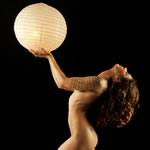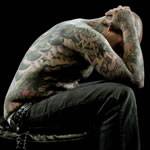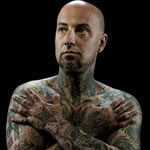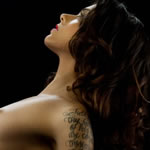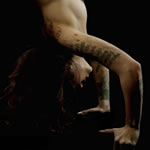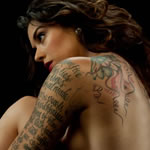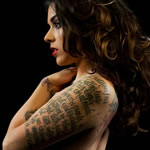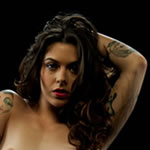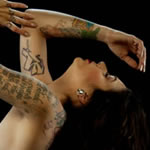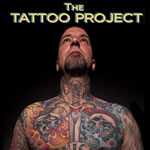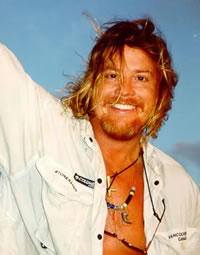Vince Hemingson ~ Interview
Do you remember the first time you saw a tattoo, and what your reaction was?
I was just a kid, but I must have been six or seven. My Uncle Al was in the Canadian Navy and had a classic maritime tattoo on his forearm. Uncle Al was a real character, and as kids we always looked forward to his visits, if only because he played the fiddle and whipped up a mean batch of buttermilk pancakes. His tattoo seemed incredibly adventuress and frankly, it never even occurred that I could have a tattoo. We're talking about the sixties after all.
Do you have any tattoos yourself?
More than a dozen now.
As a photographer, do you approach shooting a model with body art any differently than a model without tattoos?
I am always on the lookout for body art. I guess you could even say it's my job! As a photographer, I am interested in finding ways when shooting a tattoo to reveal something about the character of the individual wearing the tattoo. It's an interesting artistic tension, which takes greater precedence, the tattoo or the portrait?
Any tips for other photographers, for working with models who have tattoos?
Use body lotion to bring out the colour, lines and detail of the tattoo. I find that the more diffused your light source is, the more flattering it is to the tattoo. And usually the person you are shooting. When posing someone, I try to find a pose that shows the tattoo to its best advantage, meaning that I usually want the person to put themselves in a position similar to the one that the tattoo artist used when applying the pigment. People are three dimensional canvas'.
Are tattoos and body modifications a problem in other work that you do? Do you ever have to shoot around tattoos or use cover-up make-up? Do you ever Photo Shop out tattoos?
No.
What is it about a particular tattoo or a model with tattoos that you find interesting? Have you ever seen a tattoo, or a person with tattoos and said, "I have to shoot that!"?
All the time. Although, perhaps it's more of a case of "want to" photograph as opposed to "have to". I am always intrigued by the notion that a person's choice of body art usually reveals something rather profound about their personality or their perception of self-image. People never choose their tattoos by accident. Even if it's on a subliminal level, or if it was done as an impulse, the choice of a particular tattoo design always has some impetus behind it. There's always method behind the madness when it comes to tattoos.
As a photographer and visual artist, what defines a good tattoo in your eyes? What design and aesthetic qualities are you looking for?
In terms of line and form, a good tattoo is aesthetically pleasing and artistically distinctive. If you look at specific genres of tattooing, the traditional Japanese forms are an excellent example of this, as are Leo Zulueta's interpretation of traditional tribal tattooing forms. Of course, from a technical perspective, shading, line work, the use of negative space and how a tattoo is placed on the body reveals the talent and vision of the tattoo artist. Then again, you have the artistic tension that arises from the fact that the tattoo artist is attempting to please a client. If both of them are on the same page you are much more likely to see an amazing piece of body art.
What would be your advice to someone who wants a great photo that shows their body art to its best advantage?
Get naked. Use soft light. Apply body lotion.
What is the biggest difference between shooting editorial work - say for someone like Bob Baxter at Skin & Ink - and working in a studio?
I think Bob Baxter is a better person to answer that question. Generally, in doing editorial work, you are there to serve someone else's vision.
Any tips for taking good photos at tattoo conventions?
Avoid a flash whenever possible. Stake out a spot. And realize you are doing reportage and street photography. This may be a case where an interesting shot of the person with the tattoo is a better shot choice than concentrating on the tattoo.
What do you think of the growing numbers of celebrities and models who have tattoos?
It has certainly increased the coverage of tattoos in the mainstream media, who generally don't have a clue when it comes to reporting on tattoo culture. It's one of the main reasons I started the Vanishing Tattoo website.
What tips would you give to the home photographer, tattoo enthusiast or tattoo artist who wants to take a great photograph of a tattoo?
Try using window light. If you have a DSLR (digital single lens reflex) camera and you have to use the flash, bounce the flash off the wall or the ceiling and if you can, use the flash off camera and through a white bed sheet. A piece of paper towel over the on camera flash is still better than the flash by itself. And see above; Get naked. Use soft light. Apply body lotion.
What would be your dream tattoo photography assignment?
The Tattoo Project. I hope this is just the first of many. |

